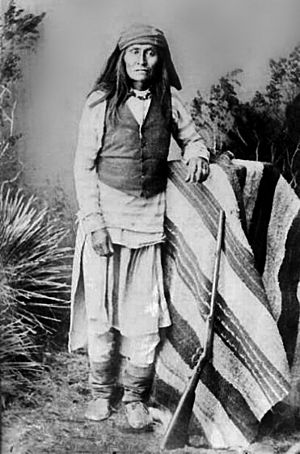Mangas Coloradas facts for kids
Quick facts for kids
Mangas Coloradas
|
|
|---|---|
| Mimbreño Apache leader | |
| Succeeded by | Delgadito (killed 1864) |
| Personal details | |
| Born |
A Bedonkohe
c. 1793 |
| Died | January 18, 1863 (aged 69–70) |
| Military service | |
| Battles/wars | Apache Wars |
Mangas Coloradas (born around 1793 – died January 18, 1863) was an important Apache tribal chief. His name means "Red Sleeve" in Spanish, but his Apache nickname was Kan-da-zis Tlishishen, meaning "Red Shirt" or "Pink Shirt." He was born with the name A Bedonkohe.
Mangas Coloradas was a member of the Mimbreño (Tchihende) division of the Central Apaches. Their homeland stretched from the Rio Grande west into what is now southwestern New Mexico. He was related to other famous Apache leaders: he was the father-in-law of Chiricahua chief Cochise, Mimbreño chief Victorio, and Mescalero chief Kutu-hala (possibly Caballero). Many people consider him one of the most important Native American leaders of the 1800s because of his battles against both Mexicans and Americans.
Mangas Coloradas married into the Copper Mines group of the Tchihende Apaches. He became the main chief of the entire Tchihende Apache division. He also had influence over the Warm Springs Mimbreño group, which was led by Chief Cuchillo Negro. Cuchillo Negro was the second chief of the Tchihende Apaches and a long-time friend of Mangas Coloradas.
Early Conflicts and Leadership
During the 1820s and 1830s, the main enemies of the Apaches were the Mexicans. Mexico had gained independence from Spain in 1821. By 1835, Mexico even offered money for Apache scalps.
In 1837, the leader of the Coppermine Mimbreño Apaches, Juan José Compa, was killed for bounty money in a terrible event at Santa Rita del Cobre. After this, Mangas Coloradas became a war leader and a chief. He joined forces with his friend Cuchillo Negro. They began to attack the Mexicans in return. They attacked the mining town of Santa Rita and a group of Mexicans trying to escape, killing many of them. Mangas Coloradas became the main leader of the Coppermine Mimbreños and led them for about 25 years. Cuchillo Negro led the Warm Springs Mimbreños.
In 1846, when the United States went to war with Mexico, the Apache Nation promised U.S. soldiers safe travel through Apache lands. Once the U.S. took over New Mexico in 1846, Mangas Coloradas signed a peace treaty. He respected the Americans because they had defeated the Mexicans, whom the Apaches disliked.
However, this peace did not last. Many gold miners started coming into New Mexico's Pinos Altos Mountains. This led to fighting between the Apaches and the Americans. In 1851, the U.S. delegation, including John Russell Bartlett, settled at Santa Rita del Cobre. The copper mines there also reopened, which made things more tense. Mangas Coloradas and other important Apache chiefs like Cuchillo Negro and Delgadito faced new problems. In June 1851, Mangas Coloradas met with Bartlett in Santa Rita del Cobre. The talks continued, but the Apaches felt disappointed and betrayed by the new arrivals.
In December 1860, 30 miners launched a surprise attack on an Apache camp near the Mimbres River. According to historian Edwin R. Sweeney, the miners "killed four Indians, wounded others, and captured thirteen women and children." Soon after this attack, Mangas Coloradas began to raid U.S. citizens and their property.
Mangas Coloradas's daughter, Dos-Teh-Seh, married Cochise, who was the main chief of the Chiricahua Apache.
In early 1861, U.S. Army Lieutenant George Nicholas Bascom was looking into the kidnapping of a rancher's son. He tricked Cochise, his family, and several warriors into a trap at Apache Pass in Arizona. Cochise managed to escape, but his family and warriors were captured. Talks failed, and fighting started. This event, known as the "Bascom affair", ended with Cochise's brother and five other warriors being killed by Bascom.
Later that year, Mangas Coloradas and Cochise formed an alliance. They agreed to try and force all Americans out of Apache territory. Other chiefs like Delgadito, Nana, Victorio, Juh, and Geronimo joined them. Even though they did not fully achieve their goal, the number of white people in Apache territory was greatly reduced for a few years during the Civil War, as federal troops were sent east.
Mangas Coloradas's Death
In the summer of 1862, Mangas Coloradas was recovering from a bullet wound. He met with someone to talk about making peace. In January 1863, he decided to meet with U.S. military leaders at Fort McLane in southwestern New Mexico. He was promised supplies in return for peace.
Mangas Coloradas arrived under a flag of truce to meet with Brigadier General Joseph R. West. West was an officer of the California militia. Armed soldiers took Mangas into custody. West then gave an order to the guards.
Men, that old murderer has got away from every soldier command and has left a trail of blood for 500 miles on the old stage line. I want him dead tomorrow morning. Do you understand? I want him dead.
That night, Mangas Coloradas was killed. The soldiers claimed he was trying to escape.
His death made the conflict between the Apaches and the United States much worse. It led Cochise to fight a nine-year campaign of revenge in Arizona and Sonora.
See also
 In Spanish: Mangas Coloradas para niños
In Spanish: Mangas Coloradas para niños



